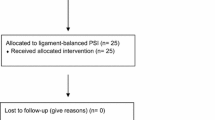Abstract
Introduction
Ligament balancing is an established surgical technique in total knee arthroplasty with good clinical results. A similar technique for unicondylar knee arthroplasty was developed. The aim of this study was to asses the outcomes of a unicondylar knee replacement implanted with a ligament tensor.
Materials and methods
A prospective multicentre study of 168 medial compartment unicondylar knee prosthesis with a minimum follow-up of 2 years. Clinically, the knee society score was recorded. For subjective assessment, the visual analogue scale (VAS) for pain and satisfaction was used. Radiographic analysis was performed to determine radiolucent lines. The surgical technique was based on a ligament-orientated procedure. With this technique, the femoral orientation, flexion/extension gaps and limb alignment is determined with a unique ligament tensor.
Results
The total KSS increased from 110.9 ± 27.5 points preoperative to 176.5 ± 21.1 points after 24 months. VAS for pain decreased from 6.0 ± 1.9 preoperative to 2.8 ± 1.7 after 24 months. VAS for satisfaction increased in the same period from 4.3 ± 1.9 to 8.9 ± 1.7. Four tibia implants had thin continuous radiolucent lines. Nine adverse events are reported. One patient died of unrelated causes. Five polyethylene inlays dislocated, one of five dislocated due to a fall. Three unicondylar knee prostheses were revised to a total knee arthroplasty, one because of undiagnosed pain, one for infection and one for femoral component malalignment.
Conclusion
We have demonstrated the efficacy of a tension-controlled ligament-balanced surgical technique for unicompartmental knee prosthesis that gives satisfying and reproducible short-term results.




Similar content being viewed by others
References
Ackroyd C, Whitehouse S, Newman J, Joslin C (2002) A comparison study of the medial St Georg sled and kinematic total knee arthroplasties. J Bone Joint Surg Br 84:667–672
Asif S, Choon D (2005) Midterm results of cemented press fit condylar sigma total knee arthroplasty system. J Orthop Surg 13:280–284
Australian Orthopaedic Association National Joint Replacement Registry (2007) Annual Report Adelaide. http://www.aoa.org.au/docs/njarep07.pdf
Bottros J, Gad B, Krebs V, Barsoum W (2006) Gap balancing in total knee arthroplasty. J Arthroplasty 21:11–15
Campbell D, Johnson L, West S (2006) Militarism quantitative computer-assisted tomography assessment of unicompartmental knee arthroplasties. ANZ J Surg 76:782–787
Cool S, Victor J, de Baets T (2006) Does a minimally invasive approach affect positioning of components in unicompartmental knee arthroplasty? Early results with survivorship analysis. Acta Orthop Belg 72:709–715
Deshmukh R, Scott R (2001) Unicompartmental knee arthroplasty. Clin Orthop 392:272–278
Fehring T (2006) Ligamentous balancing in rotating-platform knees. Orthopedics 29:S56–S59
Gleeson R, Evans R, Ackroyd C, Webb J, Newman J (2004) Fixed or mobile bearing unicompartmental knee replacement? A comparative cohort study. Knee 11:379–384
Hernigou P, Deschamps G (2004) Alignment influences wear in the knee after medial unicompartmental arthroplasty. Clin Orthop 423:161–165
Ikeuchi M, Yamanaka N, Okanoue Y, Ueta E, Tani T (2007) Determining the rotational alignment of the tibial component at total knee replacement: a comparison of two techniques. J Bone Joint Surg Br 89:45–49
Kasodekar V, Yeo S, Othman S (2006) Clinical outcome of unicompartmental knee arthroplasty and influence of alignment on prosthesis survival rate. Singapore Med J 47:796–802
Müller PE, Pellengahr C, Witt M, Kircher J, Refior HJ, Jansson V (2004) Influence of minimally invasive surgery on implant positioning and the functional outcome for medial unicompartmental knee arthroplasty. J Arthroplasty 19:296–301
Price AJ, Webb J, Topf H, Dodd CAF, Goodfellow JW, Murray DW (2001) Rapid recovery after Oxford unicompartmental arthroplasty through a short incision. J Arthroplasty 16:970–976
Robinson B, Rees JL, Price AJ, Beard DJ, Murray DW, McLardy Smith P, Dodd CAF (2002) Dislocation of the bearing of the Oxford lateral unicompartmental arthroplasty. J Bone Joint Surg Br 84:653–657
Robertsson O, Knutson K, Lewold S, Lidgren L (2001) The routine of surgical management reduces failure after unicompartmental knee arthroplasty. J Bone Joint Surg Br 83:45–49
Romero J, Stähelin T, Binkert C, Pfirrmann C, Hodler J, Kessler O (2007) The clinical consequences of flexion gap asymmetry in total knee arthroplasty. J Arthroplasty 22:235–240
Saxler G, Temmen D, Bontemps G (2004) Medium-term results of the AMC-unicompartmental knee arthroplasty. Knee 11:349–355
Swedish Knee Arthroplasty Register (2005) Annual Report. http://www.knee.nko.se/english/online/uploadedFiles/104_SKAR%202005_engl.pdf
Tabor OJ, Tabor O (1998) Unicompartmental arthroplasty: a long-term follow-up study. J Arthroplasty 13:373–379
Walton N, Jahromi I, Lewis PL, Dobson PJ, Angel KR, Campbell DG (2006) Patient-perceived outcomes and return to sport and work; total knee arthroplasty compared to mini-incision Oxford unicompartmental knee arthroplasty. J Knee Surg 19:1–5
Whiteside L (2005) Making your next unicompartmental knee arthroplasty last—three keys to success. J Arthroplasty 20:2–3
Wyss T, Schuster A, Münger P, Pfluger D, Wehrli U (2006) Does total knee joint replacement with the soft tissue balancing surgical technique maintain the natural joint line? Arch Orthop Trauma Surg 126:480–486
Acknowledgments
The statistical analysis and the work of Dr. D. H. Pfluger were supported financial by the manufacturer Mathys AG Bettlach.
Author information
Authors and Affiliations
Corresponding author
Rights and permissions
About this article
Cite this article
Campbell, D., Schuster, A.J., Pfluger, D. et al. Unicondylar knee replacement with a new tensioner device: clinical results of a multicentre study on 168 cases. Arch Orthop Trauma Surg 130, 727–732 (2010). https://doi.org/10.1007/s00402-010-1092-5
Received:
Published:
Issue Date:
DOI: https://doi.org/10.1007/s00402-010-1092-5




